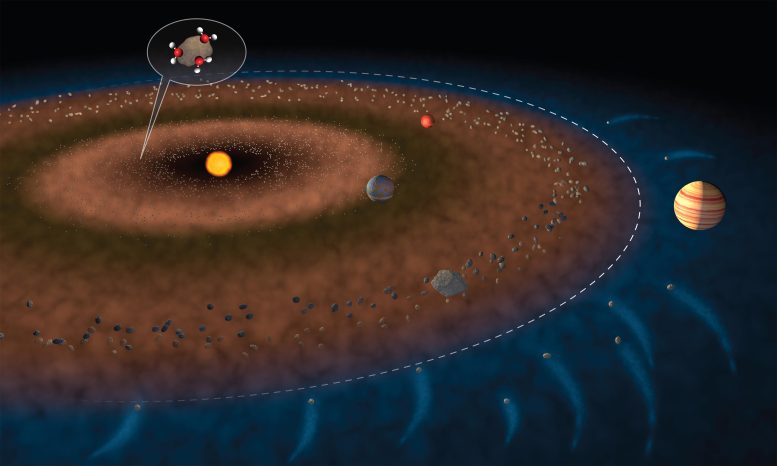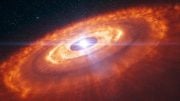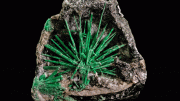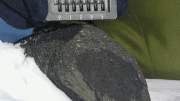
Earth’s water did not come from melted meteorites, according to a new study that analyzed melted meteorites that had been floating around in space since the solar system’s formation four and a half billion years ago. These meteorites had extremely low water content, regardless of their origin in the outer or inner solar system, ruling them out as the primary source of Earth’s water. The dashed white line in the attached illustration is the boundary with the outer solar system showing material transport from the outer solar system to the inner solar system. Credit: Illustration by Jack Cook, ©Woods Hole Oceanographic Institution
Where did Earth’s water come from? Not melted meteorites, according to scientists.
Woods Hole Oceanographic Institution is part of a collaborative study, offering new insight into the extraterrestrial origins of our lakes, rivers, and oceans.
Water makes up 71% of Earth’s surface, but no one knows how or when such massive quantities of water arrived on Earth.
A new study published on March 15 in the journal Nature brings scientists one step closer to answering that question. Sune Nielsen, associate scientist, Geology & Geophysics at the Woods Hole Oceanographic Institution (WHOI) co-authored the study, which analyzed melted meteorites that had been floating around in space since the solar system’s formation four and a half billion years ago. Researchers found that these meteorites had extremely low water content—in fact, they were among the driest extraterrestrial materials ever measured. These results, which let researchers rule them out as the primary source of Earth’s water, could have important implications for the search for water—and life—on other planets. It also helps researchers understand the unlikely conditions that aligned to make Earth a habitable planet.
The study was led by University of Maryland (UMD) Assistant Professor of Geology Megan Newcombe, with additional co-authors from the Carnegie Institution of Science.
“We wanted to understand how our planet managed to get water because it’s not completely obvious,” Newcombe said. “Getting water and having surface oceans on a planet that is small and relatively near the sun is a challenge”
The team of researchers analyzed seven melted, or achondrite, meteorites that crashed into Earth billions of years after splintering from at least five planetesimals—objects that collided to form the planets in our solar system. In a process known as melting, many of these planetesimals were heated up by the decay of radioactive elements in the early solar system’s history, causing them to separate into layers with a crust, mantle, and core.
Because these meteorites fell to Earth only recently, this experiment was the first time anyone had ever measured their water contents. UMD geology graduate student Liam Peterson used an electron microprobe to measure their levels of magnesium, iron, calcium, and silicon, then joined Newcombe at the Carnegie Instution for Science’s Earth and Planets Laboratory to measure their water contents with a secondary ion mass spectrometry instrument.
“The challenge of analyzing water in extremely dry materials is that any terrestrial water on the sample’s surface or inside the measuring instrument can easily be detected, tainting the results,” said co-author Conel Alexander, a scientist at the Carnegie Institution for Science.
To reduce contamination, researchers first baked their samples in a low-temperature vacuum oven to remove any surface water. Before the samples could be analyzed in the secondary ion mass spectrometer, the samples had to be dried out once again.
“I had to leave the samples under a turbo pump—a really high-quality vacuum—for more than a month to draw down the terrestrial water enough,” Newcombe said.
Some of their meteorite samples came from the inner solar system, where Earth is located and where conditions are generally assumed to have been warm and dry. Other, rarer samples came from the colder, icier outer reaches of our planetary system. While it was generally thought that water came to Earth from the outer solar system, it has yet to be determined what types of objects could have carried that water across the solar system.
“We knew that plenty of outer solar system objects were differentiated, but it was sort of implicitly assumed that because they were from the outer solar system they must also contain a lot of water,” said WHOI’s Nielsen. “Our paper shows this is definitely not the case. As soon as meteorites melt, there is essentially no remaining water.”
After analyzing the achondrite meteorite samples, researchers discovered that water comprised less than two-millionths of their mass. For comparison, the wettest meteorites—a group called carbonaceous chondrites—contain up to about 20% of water by weight, or 100,000 times more than the meteorite samples studied by Newcombe and co-authors.
This means that the heating and melting of planetesimals leads to near-total water loss, regardless of where these planetesimals originated in the solar system and how much water they started out with. Newcombe and co-authors discovered that, contrary to popular belief, not all outer solar system objects are rich in water. This led them to conclude that water was likely delivered to Earth via unmelted, or chondritic, meteorites.
Newcombe said their findings have applications beyond geology. Scientists of many disciplines—and especially exoplanet researchers—are interested in the origin of Earth’s water because of its deep connections with life.
“Water is considered to be an ingredient for life to be able to flourish, so as we’re looking out into the universe and finding all of these exoplanets, we’re starting to work out which of those planetary systems could be potential hosts for life,” Newcombe said. “In order to be able to understand these other solar systems, we want to understand our own.”
Reference: “Degassing of early-formed planetesimals restricted water delivery to Earth” by M. E. Newcombe, S. G. Nielsen, L. D. Peterson, J. Wang, C. M. O’D. Alexander, A. R. Sarafian, K. Shimizu, L. R. Nittler and A. J. Irving, 15 March 2023, Nature.
DOI: 10.1038/s41586-023-05721-5
This research was supported by NASA (Award Nos. 80NSSC20K0336 and 80NSSC22K0043) and a Carnegie Institution for Science postdoctoral fellowship. This story does not necessarily reflect the views of these organizations.









Be the first to comment on "New Insight Into the Extraterrestrial Origins of Earth’s Lakes, Rivers and Oceans"